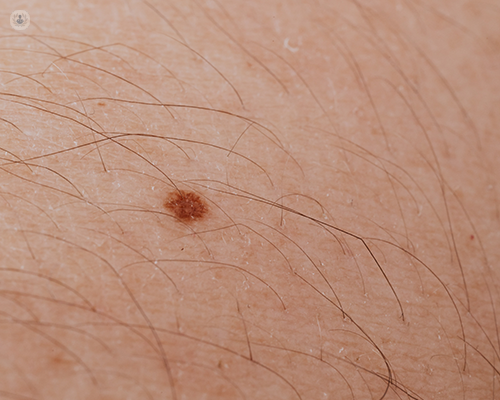Laser mole removal explained
Escrito por:Moles are frequent skin growths that can develop on any area of the body. Although most are benign (non-cancerous), certain moles may require removal for medical or cosmetic purposes.

What is laser mole removal?
Laser mole removal is a non-invasive cosmetic treatment that utilises focused laser light beams to eliminate moles from the skin. The laser targets the pigment within the mole, breaking it down into smaller particles, which are then absorbed and eliminated by the body's natural processes.
Various types of laser technology are employed:
- CO2 laser: The CO2 (carbon dioxide) laser is highly effective for removing superficial and slightly deeper moles. It works by emitting short bursts of high-energy light that vaporise the mole tissue layer by layer.
- Erbium YAG laser: The Erbium YAG laser is similar to the CO2 laser but is often preferred for its ability to remove moles with minimal damage to the surrounding skin. It’s particularly effective for smaller moles and areas requiring precision.
Can laser remove all types of moles?
Laser mole removal is most effective for certain types of moles, including:
- Pigmented moles: Lasers are particularly effective at removing moles that are flat and pigmented (dark in colour).
- Small, superficial moles: Laser removal is ideal for smaller moles that aren’t deeply rooted in the skin.
- Non-cancerous moles: Laser treatment is typically reserved for non-cancerous moles. Moles that are suspected to be cancerous or pre-cancerous should always be evaluated and removed using other methods, such as surgical excision.
How is a laser mole removal session performed?
Before the procedure, a consultation with a specialist such as a dermatologist is necessary to assess your mole and ensure it’s benign and suitable for laser removal. Your dermatologist will also discuss your medical history and any potential risks.
On the day of the procedure, the area around the mole will be cleaned, and a topical anaesthetic may be applied to minimise discomfort. In some cases, a numbing injection might be used instead.
Your dermatologist will direct the laser beam at the mole, where it will target the pigmentation or tissue. Depending on the type of laser used, the mole may be vaporised layer by layer or the pigment can be broken down and absorbed by the body.
After the mole has been removed, the area may be covered with a dressing or left open to heal. You will receive aftercare instructions, which typically include keeping the area clean, applying an antibiotic ointment, and avoiding direct sunlight on the treated area.
The actual laser treatment is quick and typically takes only a few minutes per mole. In most cases, the entire appointment, including preparation and post-procedure care, will last between 15 to 30 minutes.
Are there any potential risks or side effects?
While laser mole removal is generally safe, like any medical procedure, it may cause potential side effects. These include redness and swelling, scabbing, itching or discomfort in the treated area.
How many sessions are typically needed to remove a mole completely?
Small, superficial moles can often be effectively removed in a single session. However, larger or deeper moles may require multiple sessions, typically 2-3, spaced several weeks apart to achieve the desired result. In some cases, touch-up treatments may be necessary if the mole wasn’t fully removed or if pigmentation returns.


